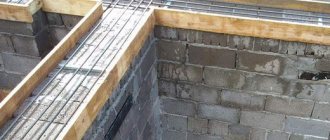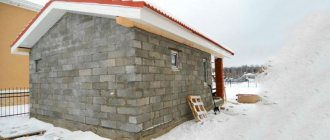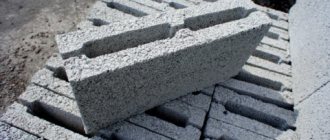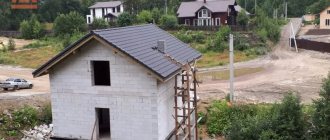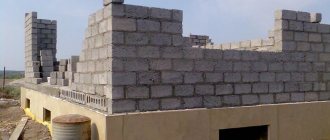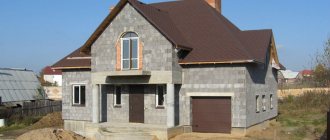Expanded clay concrete blocks are not widely used in construction, but they have taken their place in it. The construction of a house from such materials does not end with laying the roof. To maintain a normal microclimate in the premises, proper insulation of expanded clay concrete walls is required. For this purpose, different materials are used that differ in performance characteristics.
Expanded clay concrete walls need to be properly insulated.
Expanded clay concrete blocks and their purpose
The material is made from cement, water, sand and expanded clay, which plays the role of filler. Less commonly, other components are included in the composition, such as gravel and shungizite. When mixing ingredients, precise proportions are not observed; only the recommended ratios are taken into account.
Changing them affects the properties of blocks in different ways. Depending on the performance characteristics (strength, thermal conductivity), the products are used for the construction of load-bearing structures or partitions, and insulation of finished walls.
Wall mounting
Expanded clay as wall insulation is used as part of blocks and in scattered form.
You can use expanded clay to insulate walls. Moreover, the walls themselves can consist of blocks, which include this material, as well as brick or concrete. If you don’t know how to insulate the outside walls of an expanded clay concrete house, use expanded clay, it’s inexpensive and quite simple.
The instructions suggest several ways to install a thermal insulation layer:
- well masonry;
- masonry with horizontal diaphragms;
- masonry with embedded elements.
We will look at well masonry with diaphragms, so:
- We lay out the first three rows of the wall from solid brick. This is necessary to create a power belt around the perimeter of the building.
We construct the lower power belt.
- Next, we lay out the cells in the shape of a well, half a brick thick and 50 cm high.
Lay out the cells.
- We line the walls of the cells with vapor barrier or polystyrene foam. Expanded clay absorbs moisture and does not release it well, so it is necessary to prevent this process.
We install polystyrene foam or glassine.
- We fill the cells with expanded clay.
We fill in the insulation.
- We compact the insulation and make a screed along the perimeter of the wall one brick high, which will connect the inner and outer rows of the wall and protect the backfill from shrinkage.
Making a diaphragm.
Main varieties
Blocks are primarily classified according to their load-bearing capacity:
- The greatest strength is characteristic of structural types. The material is used in the construction of load-bearing elements of the house.
- Thermal insulation options are designed for insulation of residential buildings. The blocks retain heat well and have a minimum density.
- Structural and thermal insulation varieties are used in the construction of low-rise buildings. The density of materials varies from 500 to 900 kg/m³.
These types differ not only in thermal conductivity or density, but also in mass. The D500 brand unit weighs 12 kg, D900 - 17 kg.
Expanded clay concrete blocks are classified according to their load-bearing capacity.
According to the purpose of the product there are:
- Partition and wall. They are used to create load-bearing or auxiliary structures.
- Ventilation. The blocks are equipped with technological holes for connecting communication lines.
- Fundamental. Used for laying the foundations of houses. Products of standard dimensions are characterized by maximum strength and density.
Expanded clay concrete blocks can have different structures.
In accordance with this characteristic, the following types are distinguished:
- durable, heavy solid blocks;
- hollow products characterized by low weight and strength (the shape, number, and sizes of voids vary).
Useful video
In the video we will look at an example of insulating the ceiling of an extension of a private wooden house with expanded clay backfill:
You can cope with this work yourself at some stages of the preparatory work. Laying utility networks: ventilation, electrical wiring, plumbing - trust the builders who perform a range of construction and installation works.
(2 ratings, average: 5.00 out of 5)
- Features of thermal insulation
- Advantages and disadvantages
- Insulation technology
- Preparatory work
- Installation instructions
- Surface finishing
Ceiling insulation with expanded clay is an excellent alternative to using traditional thermal insulators like foam plastic or mineral wool. It makes it possible to provide high-quality heat conservation in any type of room. In addition, this method does not require significant costs.
Which is better - outside or inside?
Insulation of the facade is considered the most correct. This way the usable area of the house is not reduced. In addition, internal thermal insulation increases humidity, which leads to rotting of furniture and other wooden elements. Condensation accumulates between the wall and the insulation, gradually destroying the materials. If there is no possibility of insulating the facade, the heat insulator is laid from the inside. This requires the organization of high-quality ventilation.
The best way to insulate a house is from the outside.
How to make a thermal calculation
Calculations are performed in 2 ways: manually or using calculator programs. Self-calculation for a person without special education causes difficulties. It is best to use a special program, for example “Teremok”.
It operates in 2 modes:
- calculating the thickness of insulation;
- checking thermal conductivity for the selected material size.
Thermal calculations can be performed manually.
To work with the program, enter the following initial data:
- thermal conductivity of blocks;
- performance characteristics of insulation;
- block width.
Insulation options
It is recommended to lay the layers of the wall cake in the desired sequence. The higher the vapor permeability of the material, the closer it should be to the room.
Mineral wool
The main advantages of this material are environmental friendliness and fire safety. However, when using stone wool, a vapor barrier layer is required.
Mineral wool is environmentally friendly.
Foam plastic
When insulating a facade with this material, you need to remember that the slabs require protection from mechanical stress with plaster or siding. Polystyrene foam is characterized by low cost and ease of installation. The plates are fixed to the surface with glue and dowel nails.
Penoplex
Extruded polystyrene foam is a durable and dense insulation material that is insensitive to high humidity. It is well suited for installation on the lower parts of the facade. Expanded polystyrene is recommended to be used only for external thermal insulation: when heated, it releases toxic substances - styrene.
Penoplex is a durable and dense insulation material.
Polyurethane foam
The material is plastic filled with air bubbles. It comes in spray foam or slab form. Polyurethane foam adheres well to any surface, but it emits harmful substances when heated and is sensitive to ultraviolet rays. Before installation, you need to carefully prepare the walls.
Expanded clay
The insulation consists of porous granules made from baked clay. Bulk material is used for thermal insulation of roofs and floors. The walls are insulated only using well technology. In this case, at the construction stage, cavities are created into which granules are poured.
Expanded clay is a porous granule.
Internal or external insulation for a house made of expanded clay blocks?
Internal insulation is often done for economic reasons, so as not to have to deal with finishing the facade. This point of view is also supported by the argument that expanded clay concrete is a vapor-permeable material, so the insulation can protect the wall from steam from the interior of the house. Let's consider these arguments.
It is still necessary to finish the facade, since expanded clay concrete has a heterogeneous structure with large pores, which impairs its resistance to blowing. For this reason, even with a thick layer of insulation, the building can still be cold due to the passage of air masses through the walls. In addition, from an aesthetic point of view, expanded clay concrete does not have a very attractive appearance.
Many people believe that expanded clay concrete should be pink or brown, the color of expanded clay. This idea was formed due to the dyes that some manufacturers add to the blocks. In fact, the natural color of expanded clay concrete is gray.
The second argument also does not stand up to criticism, since not all insulation materials have low vapor permeability. Such properties are characteristic of EPS (expanded polystyrene) and EPS (extruded polystyrene foam), and their use for internal insulation is not recommended due to their high flammability.
Also, internal insulation reduces the living space of the premises.
Insulation methods and step-by-step instructions
The thermal insulation layer is laid both outside and inside the house. Less commonly used is the well method, in which the material is poured between 2 layers of masonry. Experts recommend insulating the building on both sides.
Internal insulation has the following disadvantages:
- reduction of usable space;
- exposure of the facade to atmospheric factors;
- formation of condensation between the wall and the insulation.
External insulation of the house
Based on the type of materials used and the technology of their installation, the following external thermal insulation methods are distinguished:
- “wet” façade;
- well insulation;
- ventilated facade.
First, a thermal insulation layer is laid.
Wet insulation method
In this case, mineral wool, penoplex or polystyrene foam are used.
The work is carried out as follows:
- Level the walls, sealing depressions, protrusions and interblock seams.
- If there are pronounced defects, a layer of plaster is applied to the surface. In other cases, they are limited to priming.
- Apply glue to the surface of the insulating boards. Apply the material to the wall. After the solution has hardened, the slabs are fixed with dowels.
- Plaster is applied and a reinforcing mesh is installed.
- The walls are covered using façade mixtures. If necessary, after the plaster has dried, the surfaces are painted.
With the wet insulation method, a layer of plaster is applied to the walls.
Dry insulation method
This option requires the installation of lathing and the use of waterproofing membranes.
Warming is done as follows:
- Close the interblock joints with cement-sand mortar. Remove the remaining masonry mixture.
- A vapor barrier membrane is laid.
- A frame is constructed from wooden beams or metal profiles, taking into account the parameters of heat-insulating boards.
- A waterproofing membrane is fixed to the sheathing. At this stage, 2 cm thick slats are used. They form a ventilation gap.
- The façade is clad using the chosen method.
The dry insulation method requires the installation of sheathing.
Kolodeznoye
The method can only be used at the stage of building a house made of expanded clay blocks. It is impossible to fill in insulating granules if the walls have already been erected.
Expanded clay must remain inside the structure.
What is the best way to insulate?
Any insulation from the following list will be good thermal insulation for expanded clay blocks:
- glass wool;
- mineral wool;
- Styrofoam;
- expanded polystyrene (penoplex);
- polyurethane foam;
- liquid materials.
Glass wool is one of the most traditional and cheapest insulation materials . Its advantages are frost resistance and air non-conductivity. The disadvantages are low environmental friendliness and the risk of injury if installed incorrectly.
Mineral wool made from basalt or slag does not have these disadvantages: it is more environmentally friendly, is not flammable and retains heat better. However, it costs more than glass wool and is susceptible to moisture stagnation.
Polystyrene foam as insulation is relatively cheap , it is lightweight and very easy to attach to walls. Its disadvantage is rapid deterioration under the influence of moisture, insects, rodents and birds (to avoid this, it must be reinforced with mesh).
Expanded polystyrene is similar to polystyrene foam in terms of thermal protection, but this material is not susceptible to rodents, so it is more expensive. It is considered one of the most suitable materials for thermal insulation of expanded clay walls. It minimizes the number of cold bridges between blocks and is also easy to install. The material is dense and durable, not afraid of moisture.
Polyurethane foam copes well with protection from dampness , since it has a high degree of water resistance and retains heat well. However, it is quite expensive and requires special equipment and tools for installation.
Liquid insulation consists of two components - polyurethane foam and penoizol. This composition retains moisture and air and is easily applied by spraying onto a special sheathing. The downside is the cost, as well as the inability to immediately begin plastering work - after all, the finish must be fixed with a frame.

